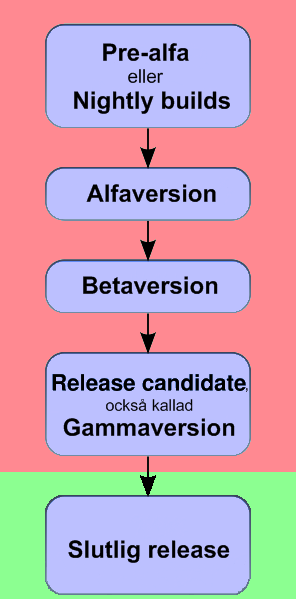Version control is the software engineering practice of controlling computer files and versions of files; primarily source code text files, but generally any type of file.
Test-driven development (TDD) is a way of writing code that involves writing an automated unit-level test case that fails, then writing just enough code to make the test pass, then refactoring both the test code and the production code, then repeating with another new test case.
In software testing, test automation is the use of software separate from the software being tested to control the execution of tests and the comparison of actual outcomes with predicted outcomes. Test automation can automate some repetitive but necessary tasks in a formalized testing process already in place, or perform additional testing that would be difficult to do manually. Test automation is critical for continuous delivery and continuous testing.
In software development, distributed version control is a form of version control in which the complete codebase, including its full history, is mirrored on every developer's computer. Compared to centralized version control, this enables automatic management branching and merging, speeds up most operations, improves the ability to work offline, and does not rely on a single location for backups. Git, the world's most popular version control system, is a distributed version control system.
Release engineering, frequently abbreviated as RE or as the clipped compound Releng, is a sub-discipline in software engineering concerned with the compilation, assembly, and delivery of source code into finished products or other software components. Associated with the software release life cycle, it was said by Boris Debic of Google Inc. that release engineering is to software engineering as manufacturing is to an industrial process:
Release engineering is the difference between manufacturing software in small teams or startups and manufacturing software in an industrial way that is repeatable, gives predictable results, and scales well. These industrial style practices not only contribute to the growth of a company but also are key factors in enabling growth.
Build automation is the practice of building software systems in an relatively unattended fashion. The build is configured to run with minimized or no software developer interaction and without using a developer's personal computer. Build automation encompasses the act of configuring the build system as well the resulting system itself.
AnthillPro is a software tool originally developed and released as one of the first continuous integration servers. AnthillPro automates the process of building code into software projects and testing it to verify that project quality has been maintained. Software developers are able to identify bugs and errors earlier by using AnthillPro to track, collate, and test changes in real time to a collectively maintained body of computer code.
Multi-stage continuous integration is a software development technique intended to achieve highly integrated parallel development activity while reducing the scope of integration problems.

Release management is the process of managing, planning, scheduling and controlling a software build through different stages and environments; it includes testing and deploying software releases.
DevOps is a methodology in the software development and IT industry. Used as a set of practices and tools, DevOps integrates and automates the work of software development (Dev) and IT operations (Ops) as a means for improving and shortening the systems development life cycle. DevOps is complementary to agile software development; several DevOps aspects came from the agile way of working.
Continuous testing is the process of executing automated tests as part of the software delivery pipeline to obtain immediate feedback on the business risks associated with a software release candidate. Continuous testing was originally proposed as a way of reducing waiting time for feedback to developers by introducing development environment-triggered tests as well as more traditional developer/tester-triggered tests.
Continuous delivery (CD) is a software engineering approach in which teams produce software in short cycles, ensuring that the software can be reliably released at any time and following a pipeline through a "production-like environment", without doing so manually. It aims at building, testing, and releasing software with greater speed and frequency. The approach helps reduce the cost, time, and risk of delivering changes by allowing for more incremental updates to applications in production. A straightforward and repeatable deployment process is important for continuous delivery.

BuildMaster is an application release automation tool, designed by the software development team Inedo. It combines build management and ARA capabilities to manage and automate processes primarily related to continuous integration, database change scripts, and production deployments, overall releasing applications reliably. The tool is browser-based and able to be used "out-of-the-box". Its feature set and scope puts it in line with the DevOps movement, and is marketed as "more than a release automatigs together the people, processes, and practices that allow teams to deliver software rapidly, reliably, and responsibly.” It's a tool that embodies incremental DevOps adoption.
In software development, a neutral build is a software build that reflects the current state of the source code checked into the source code version control system by the developers, and done in a neutral environment.
In software deployment, an environment or tier is a computer system or set of systems in which a computer program or software component is deployed and executed. In simple cases, such as developing and immediately executing a program on the same machine, there may be a single environment, but in industrial use, the development environment and production environment are separated, often with several stages in between. This structured release management process allows phased deployment (rollout), testing, and rollback in case of problems.
Probo is a user automated testing tool that provides continuous integration, workflow organization and quality assurance using the same tool for project managers and developers.
Wercker is a Docker-based continuous delivery platform that helps software developers build and deploy their applications and microservices. Using its command-line interface, developers can create Docker containers on their desktop, automate their build and deploy processes, testing them on their desktop, and then deploy them to various cloud platforms, ranging from Heroku to AWS and Rackspace. The command-line interface to Wercker has been open-sourced.
In software engineering, CI/CD or CICD is the combined practices of continuous integration (CI) and continuous delivery (CD) or, less often, continuous deployment. They are sometimes referred to collectively as continuous development or continuous software development.
TestOps refers to the discipline of managing the operational aspects of testing within the software delivery lifecycle.


